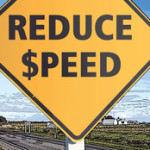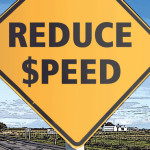Why High-Frequency Trading Doesn't Compute – Barron's

Wall Street is no autobahn. Traders pushing pedal to the metal risk hurtling into the Buttonwood Trees.
Knight Capital’s $440 million computer-generated smash-up this month is the latest sign that the world’s most important financial superhighway, where trades take place in less than the blink of an eye, sorely needs a speed limit.
Michael Goldstein, a professor of applied investments at Babson College and a noted advisor on market regulators, suggests slowing traffic to 10 milliseconds—a millisecond is 1/1,000th of a second—the limit in 2007. Today, trades zip by in a fraction of a millisecond, depending on the distance between the robot and the data centers of the nation’s 15 stock exchanges and 40 or so “dark pools”—electronic trading venues designed to handle large institutional orders. Traders hooked on the advantages of speed might grumble; but Goldstein doubts that they would abandon Wall Street for some market abroad. It takes about 17 milliseconds to send a trade from New York to London and even more time to Asian markets like Singapore.
EVEN A SPEED LIMIT OF five milliseconds could reduce the pileups on Wall Street, Goldstein contends. To high-speed-trading robots, a few milliseconds is an eternity—providing plenty of time for machine and operator to spot and rectify errors they might not notice when data are flowing at lightning speed.
Changes in regulations by the Securities and Exchange Commission at the beginning of this century that tried to increase competition among exchanges and bring down customers’ costs emphasized speed in the execution of orders. Prior to that, exchanges like Nasdaq would slow down trades from the East Coast so that those from the West Coast could catch up. Exchange officials felt it unfair to give New Yorkers an advantage based solely on geography. But when the SEC allowed other exchanges to trade stocks listed on Nasdaq or the NYSE, the faster traders got the best executions.
With robots working at frantic speeds, a simple trading error can repeat itself millions of times before a machine’s human masters can detect it.
Radius Images/Corbis
Hasty preparation of software for a high-speed computer might have caused Knight Capital to spin out. A newly minted algorithm designed to participate in a fledgling NYSE program offering price improvement to retail customers mistakenly ordered the market-making firm’s computers to purchase $4.5 billion worth of stock in the first 45 minutes of the trading day. What’s more, the humans there didn’t realize that a problem existed until they got a phone call from the New York Stock Exchange, where most of the errant trades were being executed. Suspicions on the Street and in regulatory circles are that the software had been inadequately road-tested. The SEC is trying to come up with a definitive answer.
Knight Capital’s off-road experience was the fourth major computer-related market accident this year.
The three others: In February, the electronic oil-trading platform at the CME in Chicago crashed, forcing trades to temporarily migrate to the slower flesh-and-blood open-cry pits in New York. In March, the seven-year-old BATS electronic exchange had to cancel its initial public stock offering when a glitch in its own computer system prevented its shares from opening. And in May, a computer snafu at the Nasdaq-OMX market famously disrupted the initial public offering of Facebook, the Street’s most highly anticipated event of the year. Regulatory steps following the notorious Flash Crash in May 2010 were supposed to prevent this sort of stuff.
Additionally, there have been hundreds of highly disturbing fender benders. On May 18, quotes and trades from reporting exchange Nasdaq for all NYSE, AMEX, ARCA, and Nasdaq-listed stocks stopped, beginning at 11:29:52 a.m. and continuing for almost 17 seconds, says Eric Hunsader of Nanex, a market-data firm in Winnetka, Ill. Seventeen seconds is “an eternity by high-frequency trading standards,” says Hunsader, who continually sends out Twitter updates on bizarre, computer-generated market movements.
The Bottom Line
A speed limit of 10 milliseconds for high-frequency-trading robots would cut down on the number and the severity of computer-generated market disruptions.
In order to work, Goldstein’s speed limit would have to be universal. Exchanges make good money serving high-frequency traders. The owners of these over-clocked, nitrogen-cooled robots pay handsome annual rents to put their machines in the data centers housing the exchange’s own servers. They want to be first in line to buy or sell when a stock is moving up or down. Because data move through wires and airwaves, the closer the robot is to an exchange’s servers, the faster it can trade.
SO PROFITABLE IS THIS “ROBOTEL” model that NYSE-Euronext in 2010 opened a $600 million, 400,000-square-foot facility—the equivalent of seven football fields—in Mahwah, N.J.
NYSE-Euronext hardly is alone. Most of the 15 stock exchanges in the U.S., as well as the CME, the world’s largest commodities exchange, have built similarly expansive robotels. High-frequency trades account for more than 70% of daily volume on the exchanges and about 18% of profits, though this latter figure is expected to grow robustly.
Some exchanges might welcome speed limits. Co-location space still would remain valuable. But more importantly, one executive says, speed limits would restore retail investors’ confidence in the market’s fairness. Lack of trust is keeping much of the small fry away.
Robots are grand—but the exchanges make much more money off us dumb humans than they do on the super-smart machines. Putting the interests of high-frequency traders above everyone else’s simply doesn’t compute.
E-mail: [email protected]
Source:
Why High-Frequency Trading Doesn't Compute – Barron's
See which stocks are being affected by Social Media


